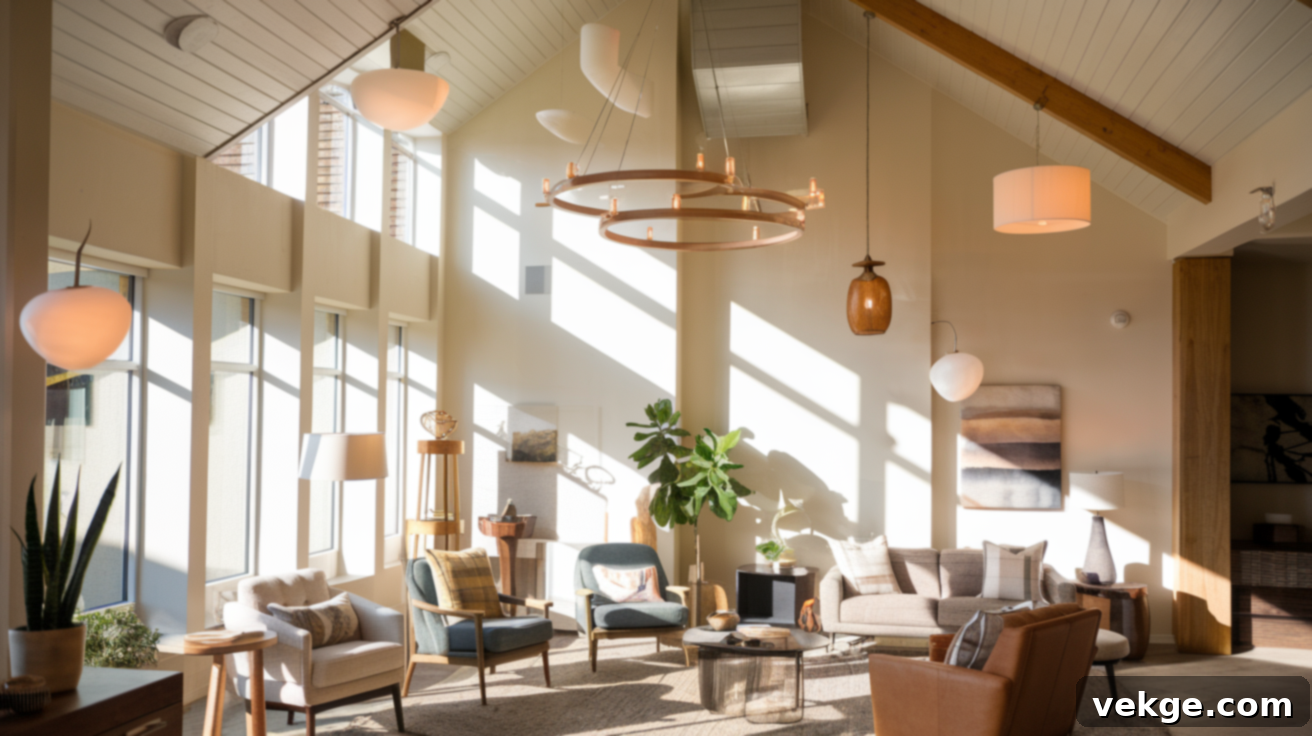Illuminate Your Heights: The Ultimate Guide to Vaulted Ceiling Lighting
Have you ever stepped into a room with a magnificent vaulted ceiling, only to find yourself puzzled about how to light it effectively? You’re not alone. Vaulted ceilings, while undeniably beautiful and grand, introduce unique lighting challenges that flat ceilings simply don’t. Their impressive height and varying slopes fundamentally alter how light spreads throughout a space, often leading to dim corners, uneven illumination, or a general lack of warmth and balance in the room’s ambiance.
This comprehensive guide is designed to demystify vaulted ceiling lighting, offering you a step-by-step approach to brightening your unique space. We’ll delve into the intricacies of vaulted ceilings, explore the diverse range of lighting fixtures best suited for them, and provide practical advice on placement, installation, and long-term care. Furthermore, you’ll discover how to leverage smart features and energy-efficient solutions to create a truly brilliant and sustainable environment.
By the end of this guide, you will gain a clear understanding of the best lighting strategies for your vaulted ceilings, empowering you to confidently select and implement the perfect illumination plan. Get ready to transform your space, making it feel lighter, more inviting, and perfectly balanced.
Understanding Vaulted Ceilings: A Foundation for Brilliant Lighting
Vaulted ceilings are architectural statements that soar higher than conventional flat ceilings, typically following the slope and contour of the roofline. This design choice instantly makes a room feel more expansive, airy, and luxurious, often inviting more natural light into the space. However, their very nature—the increased height and dramatic angles—also presents specific considerations when planning your lighting scheme. Understanding the characteristics of your vaulted ceiling is the first step toward choosing the most effective and aesthetically pleasing lighting solutions.
What is a Vaulted Ceiling?
At its core, a vaulted ceiling is any ceiling that angles upward, deviating from a flat horizontal plane. Instead of a standard, uniform height, it rises towards the roof structure, creating various slopes, arches, or sometimes a combination of both. This upward sweep significantly increases the vertical volume of a room, often leading to a more open, grand, and impressive atmosphere. When strategically combined with windows, especially clerestory windows or skylights, vaulted ceilings can dramatically enhance natural light penetration, making rooms feel even brighter and more connected to the outdoors.
Common Types of Vaulted Ceilings
While the term “vaulted ceiling” is broad, several distinct types offer different aesthetics and present unique lighting opportunities:
- Cathedral Ceilings: Characterized by two equal sloping sides that meet at a central, elevated ridge, resembling an inverted ‘V’. These are often found in great rooms and living areas, creating a very grand and symmetrical look.
- Barrel Ceilings: These ceilings are gracefully rounded and smooth, mimicking the interior of a barrel or a continuous arch. They add a sophisticated, old-world charm and can make a long hallway or room feel more expansive and intimate simultaneously.
- Dome Ceilings: As the name suggests, these ceilings curve upward in a circular or hemispherical shape, often centered over a specific area or room. Dome ceilings are typically found in foyers, dining rooms, or architectural focal points, offering a sense of grandeur and uniqueness.
- Sloped Ceilings: Sometimes called shed ceilings, these feature a single, continuous angle that follows the roofline. They are less dramatic than cathedral vaults but still offer increased height and a modern, often minimalist aesthetic, commonly seen in contemporary homes and lofts.
Why Lighting These Ceilings is Unique
The inherent height and often dramatic slant of vaulted ceilings pose distinct challenges for conventional lighting. Standard ceiling lights, designed for flat, lower ceilings, struggle to distribute light evenly across such a large and varied volume of space. This can result in several issues:
- Uneven Light Distribution: Light sources mounted too low might only illuminate the immediate area beneath them, leaving vast stretches of the ceiling and upper walls in shadow. Conversely, lights mounted too high might scatter light too broadly, reducing its intensity where it’s needed most.
- Shadows and Glare: The angles can create harsh shadows in corners or along the slopes, disrupting the visual flow. Improperly aimed lights can also cause uncomfortable glare, especially when viewed from different angles in the room.
- Difficulty in Maintenance: Changing bulbs or cleaning fixtures in high vaulted ceilings can be a significant chore, requiring specialized equipment like tall ladders or extension poles.
- Aesthetic Harmony: The sheer scale of a vaulted ceiling demands lighting fixtures that are appropriately sized and styled to complement, rather than detract from, its architectural grandeur. Small, understated fixtures can get lost, while overly ornate ones might overwhelm the space.
Therefore, successful vaulted ceiling lighting requires careful consideration of fixtures that can work harmoniously with the height and angles, ensuring comfortable, well-distributed illumination throughout the entire room while enhancing its unique architectural character.
Best Vaulted Ceiling Lighting Fixtures: Illuminating Your Unique Space
Vaulted ceilings are a show-stopping feature, and selecting the right lighting is crucial to accentuating their beauty and ensuring functional illumination. The key is to choose fixtures that can project light effectively across the expanded volume and complement the room’s aesthetic. Here are some of the best lighting options tailored for vaulted ceilings, helping you brighten your space with both style and efficiency.
1. Chandeliers
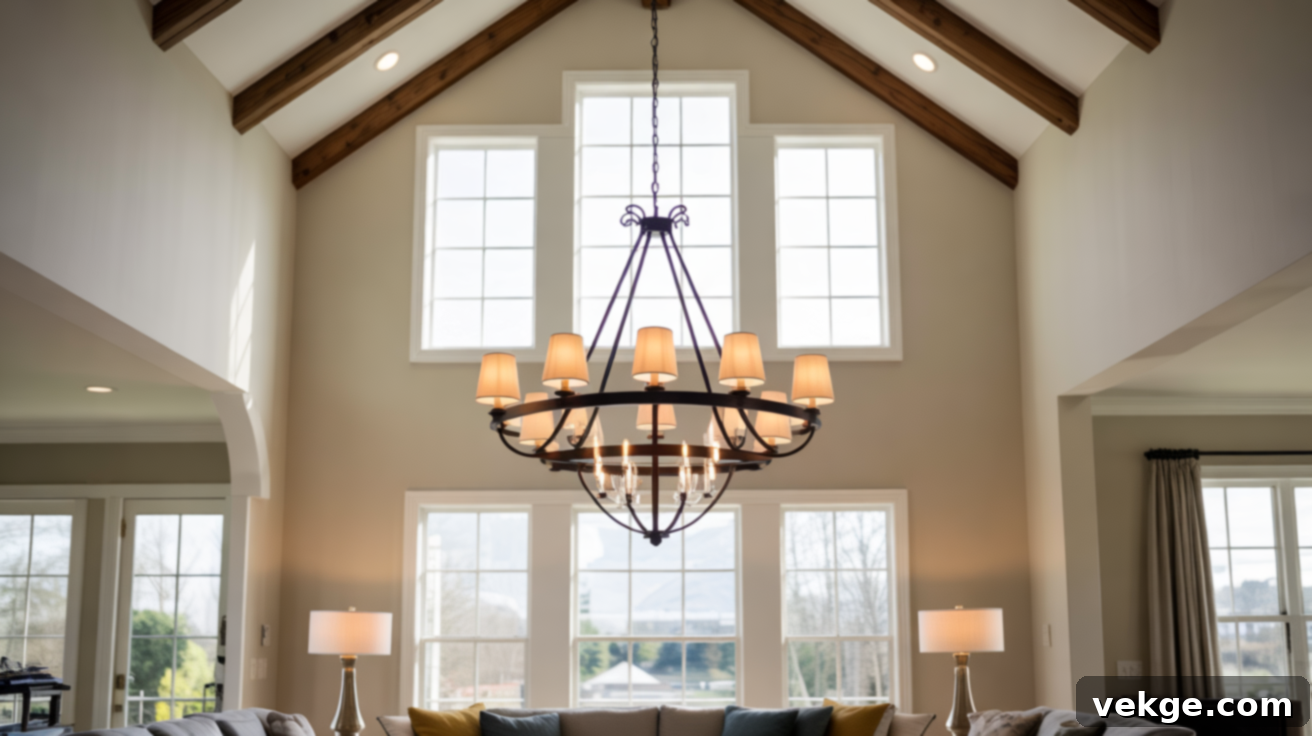
Best for: Living rooms, dining rooms, grand entryways, and stairwells.
Chandeliers are the quintessential choice for vaulted ceilings, acting as a magnificent focal point while effectively filling the expansive vertical space. Their presence adds a sense of grandeur and elegance, making a statement that draws the eye upward. When selecting a chandelier, ensure its size is proportional to both the room’s dimensions and the ceiling’s height. A common guideline suggests that for every foot of ceiling height above 8 feet, you can add 3 inches to the ideal diameter of your chandelier.
Style and setup tips:
- Proportional Sizing: Opt for a larger chandelier than you would for a flat ceiling to ensure it doesn’t get lost in the vastness. Consider the room’s width and length (in feet) and add them together to get a rough idea of the ideal chandelier diameter in inches. For vaulted ceilings, you can typically go even larger.
- Clearance Matters: Ensure there’s at least 7 feet of clearance from the bottom of the chandelier to the floor in walking areas to prevent head bumps. In dining rooms, 30-36 inches above the table is generally ideal.
- Visual Harmony: While ornate designs can be stunning, simpler shapes and cleaner lines often integrate better with modern or minimalist vaulted spaces, preventing the room from feeling too busy or cluttered.
- Installation: Due to the slope, you may need a sloped ceiling adapter kit for proper installation, ensuring the chandelier hangs vertically.
2. Pendant Lights
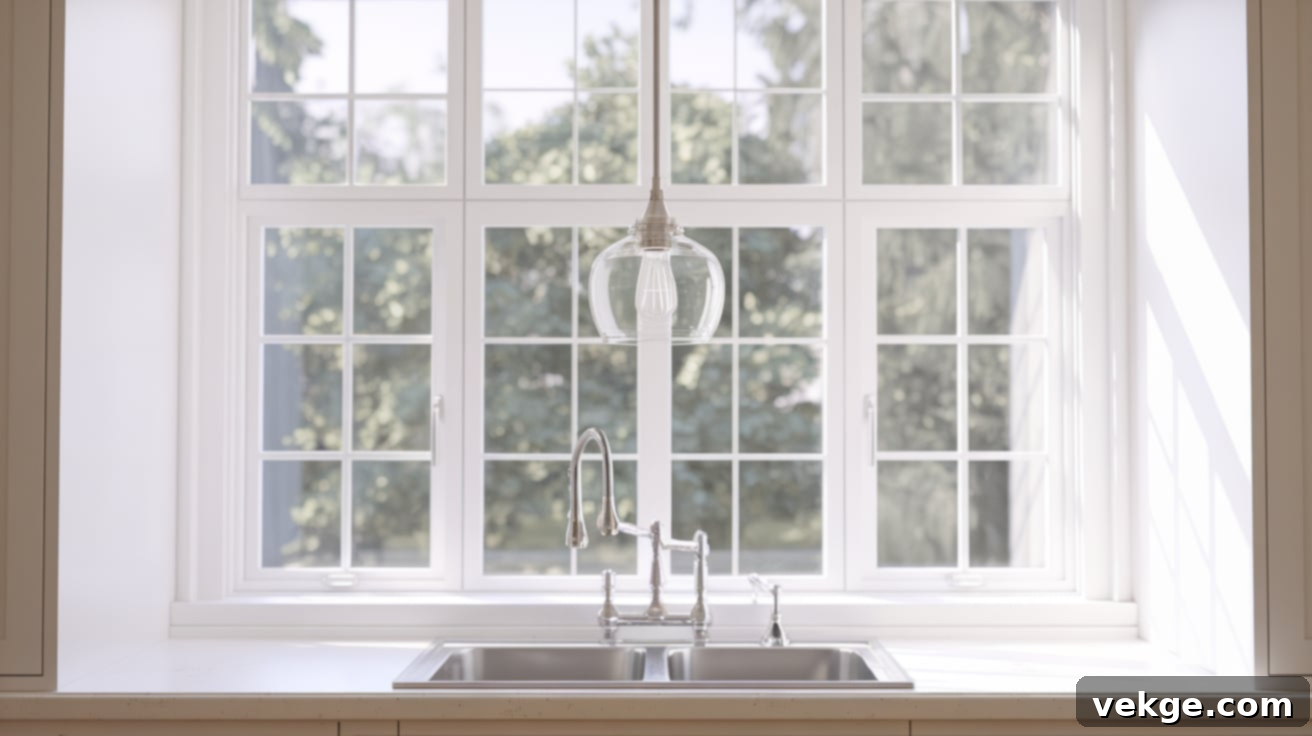
Ideal for: Kitchen islands, breakfast bars, entryways, and stairwells where focused lighting or a series of decorative lights is desired.
Pendant lights offer versatility and a modern aesthetic, hanging down from the ceiling to provide more direct and focused illumination. They are particularly effective for task lighting over surfaces or for creating visual interest in areas that benefit from vertical accents. Their adjustable nature makes them excellent for vaulted ceilings, as you can customize their hanging length.
How to hang them:
- Adjustable Lengths: Choose pendants with adjustable cords or rods, allowing you to fine-tune their height to suit the specific area and ceiling slope. This is crucial for maintaining an even line or creating a staggered, dynamic effect.
- Groupings: When installing multiple pendants, especially over an island or in a stairwell, using odd numbers (e.g., three or five) often creates a more balanced and aesthetically pleasing arrangement.
- Optimal Height: Over kitchen islands or dining tables, aim for approximately 30-36 inches between the bottom of the pendant and the surface below to prevent obstruction and ensure effective task lighting.
- Sloped Adapters: Like chandeliers, pendants will likely require a sloped ceiling adapter to hang straight down from an angled ceiling.
3. Recessed Lighting
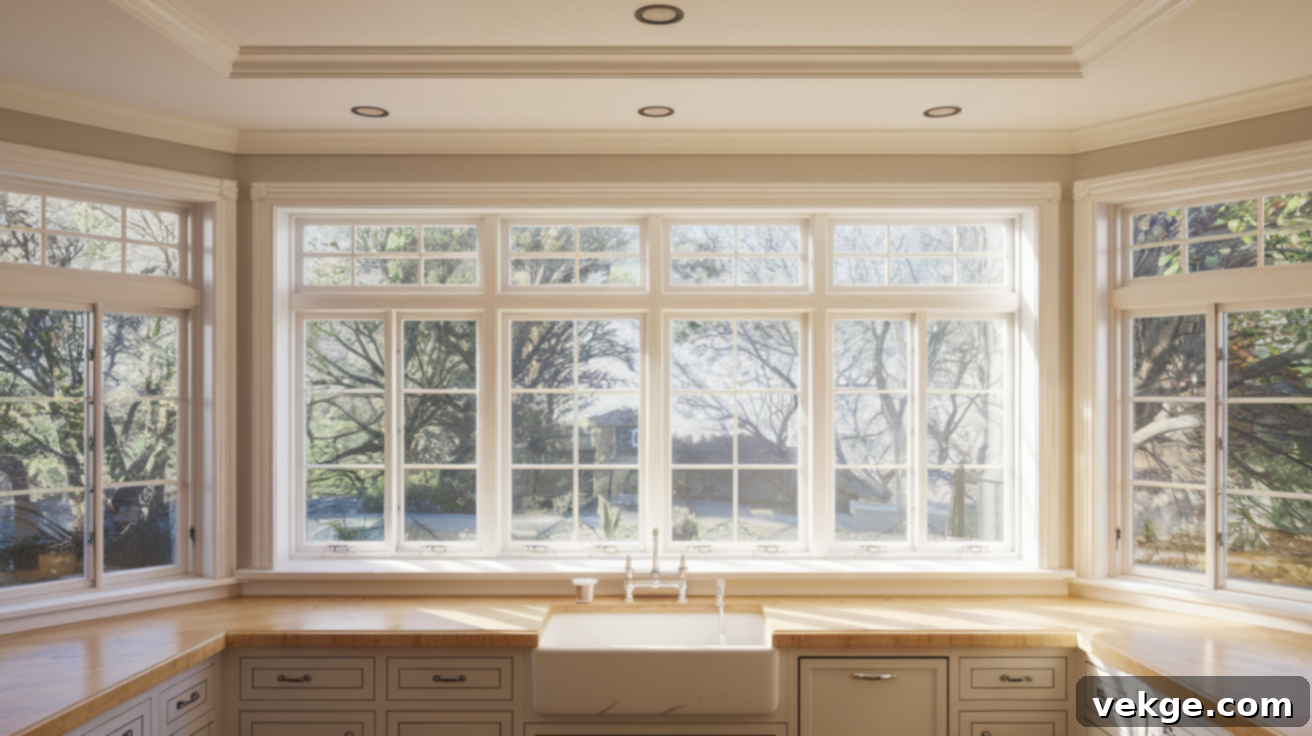
Good for: Creating a clean, unobtrusive, and evenly lit environment, suitable for almost any room with a vaulted ceiling.
Recessed lights, or can lights, are installed directly into the ceiling, offering a sleek, low-profile look that provides soft, ambient illumination without drawing attention to the fixtures themselves. They are excellent for general lighting and can be strategically placed to wash the vaulted ceiling in light, reducing harsh shadows and making the space feel more open. When installing in vaulted ceilings, special “sloped ceiling” recessed housings and trims are available that allow the light to project straight down, even though the ceiling is angled.
Layout and spacing ideas:
- Match the Slope: Place recessed lights in rows that follow the ceiling’s slope or create an even grid pattern, ensuring uniform light distribution. Closer spacing is generally required for higher vaulted ceilings to achieve adequate brightness.
- Beam Angles: Use a mix of narrow beam angles (spotlights) to highlight architectural features or artwork, and wider beam angles (floodlights) for general, ambient illumination across the broader ceiling expanse.
- Dimmers are Key: Install dimmers to allow for flexible control over brightness, enabling you to adjust the mood and intensity of the light from bright task lighting to a subtle, ambient glow.
- Color Temperature: Consider the color temperature (Kelvin) of the LED bulbs; warmer tones (2700K-3000K) create a cozy atmosphere, while cooler tones (3500K-4000K) are better for task-oriented areas.
4. Ceiling Fans with Lights
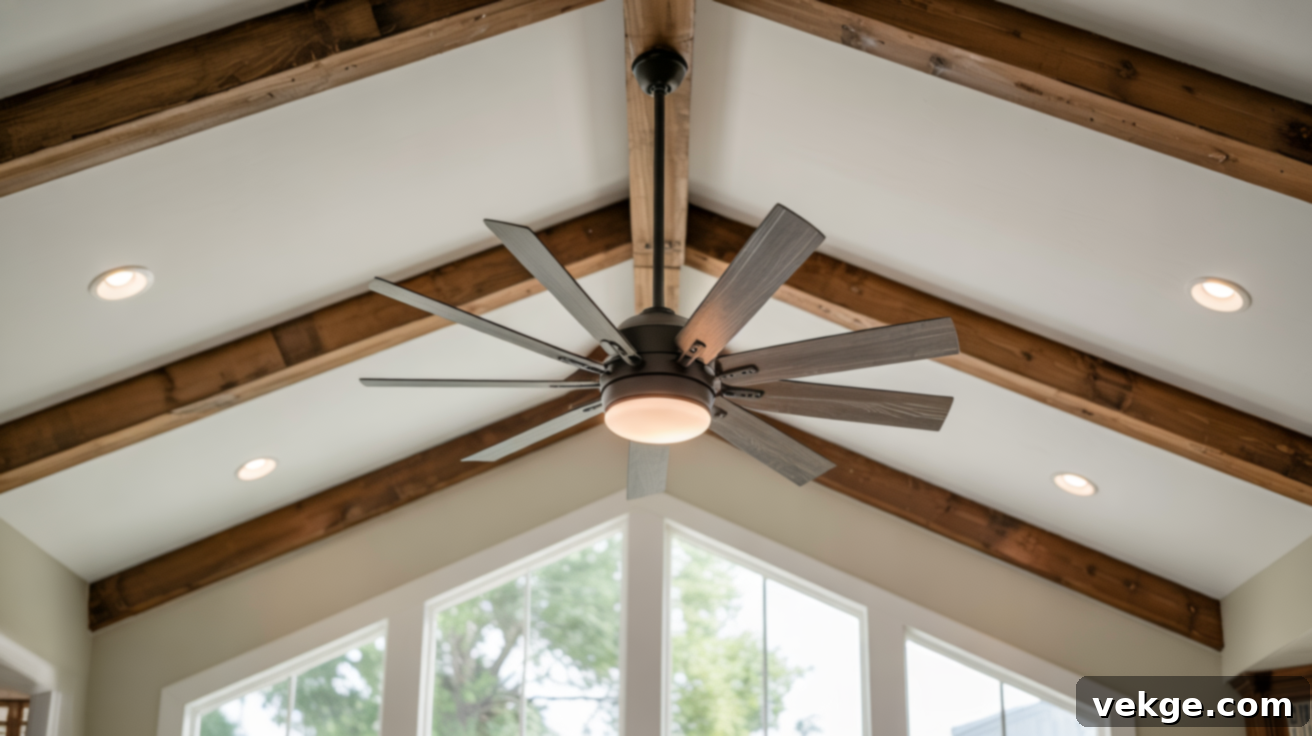
Best for: Warm climates, large living spaces, bedrooms, or any room where both air circulation and overhead lighting are desired.
Ceiling fans equipped with integrated lighting offer a practical dual function: they provide effective air movement to cool down large rooms or distribute heat more evenly, while simultaneously offering a central light source. For vaulted ceilings, they can be an excellent choice, especially when sized appropriately for the room to ensure both functional air circulation and adequate lighting.
Things to check:
- Downrod for Slope: A specific downrod or an angled mounting kit is essential for sloped ceilings to ensure the fan hangs level and operates safely and efficiently. The longer the downrod, the closer the fan is to your living space, enhancing its cooling effect.
- Blade Clearance: Ensure the fan blades have ample clearance from the ceiling (at least 10-12 inches) and surrounding walls (at least 18-24 inches) to spin freely without obstruction or creating turbulence.
- Aesthetic Match: Choose a fan and light kit that complements the room’s overall decor, material palette, and color scheme. Many modern fans offer sleek, integrated LED light panels for a seamless look.
- Remote Control: For high ceilings, a fan with a remote control or smart home integration is highly recommended for easy operation of both fan speed and light settings.
5. Track Lighting
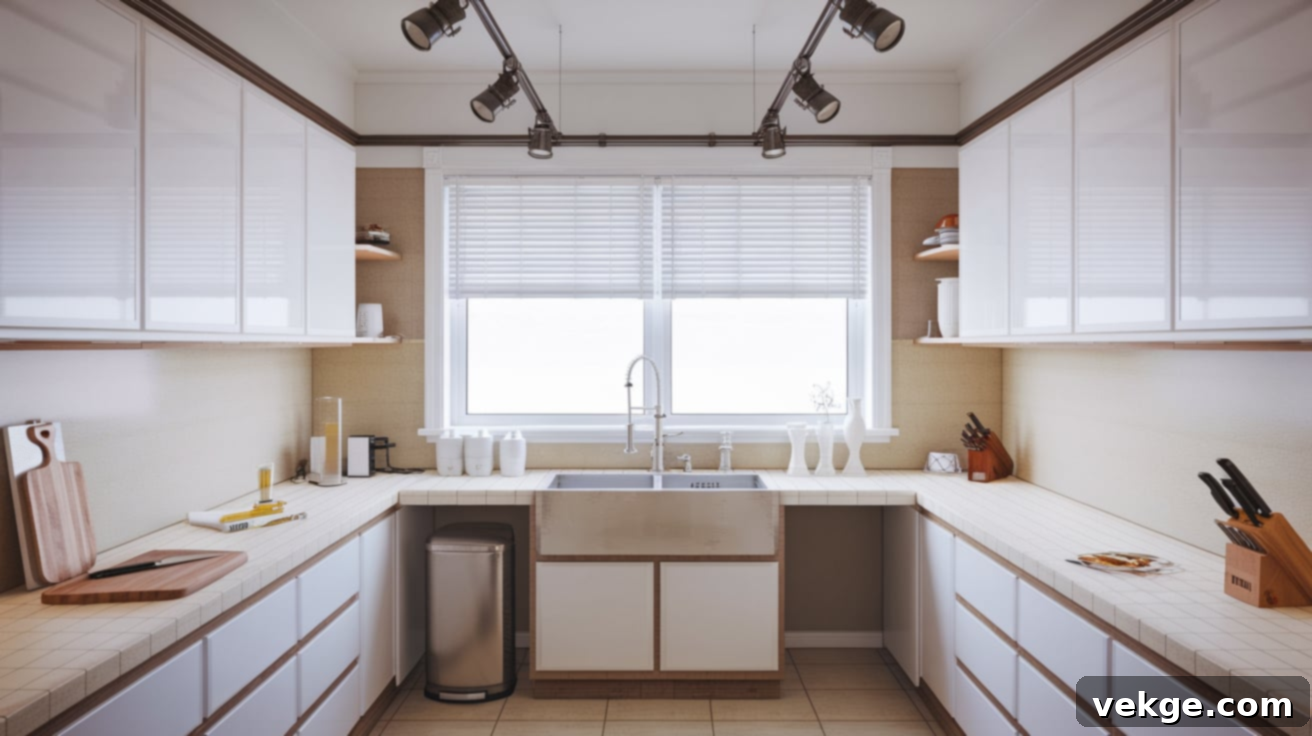
Ideal for: Modern spaces, art galleries, or rooms with flexible layouts where adjustable and directional lighting is a priority.
Track lighting systems consist of a linear track that mounts to the ceiling, onto which multiple light heads can be attached. This allows for immense flexibility, as each light head can be moved, rotated, and aimed independently. This adaptability makes track lighting exceptionally suitable for vaulted ceilings, where you might need to direct light to specific areas, accent architectural features, or illuminate artwork on sloped walls.
Placement and use:
- Mounting Options: The track can be mounted directly along the slope of the ceiling or suspended via adjustable rods to hang horizontally, depending on the desired effect and ceiling height.
- Adjustable Heads: Utilize the adjustable heads to aim light precisely where it’s needed – whether for general ambient lighting, task lighting in a kitchen, or highlighting a specific wall texture or art piece.
- Dimmers for Control: Pair track lighting with a dimmer switch to easily adjust the overall brightness and create various moods within the space.
- Versatile Styles: Track heads come in various styles, from minimalist cylinders to more decorative options, allowing you to match your room’s aesthetic.
6. Rail Lighting
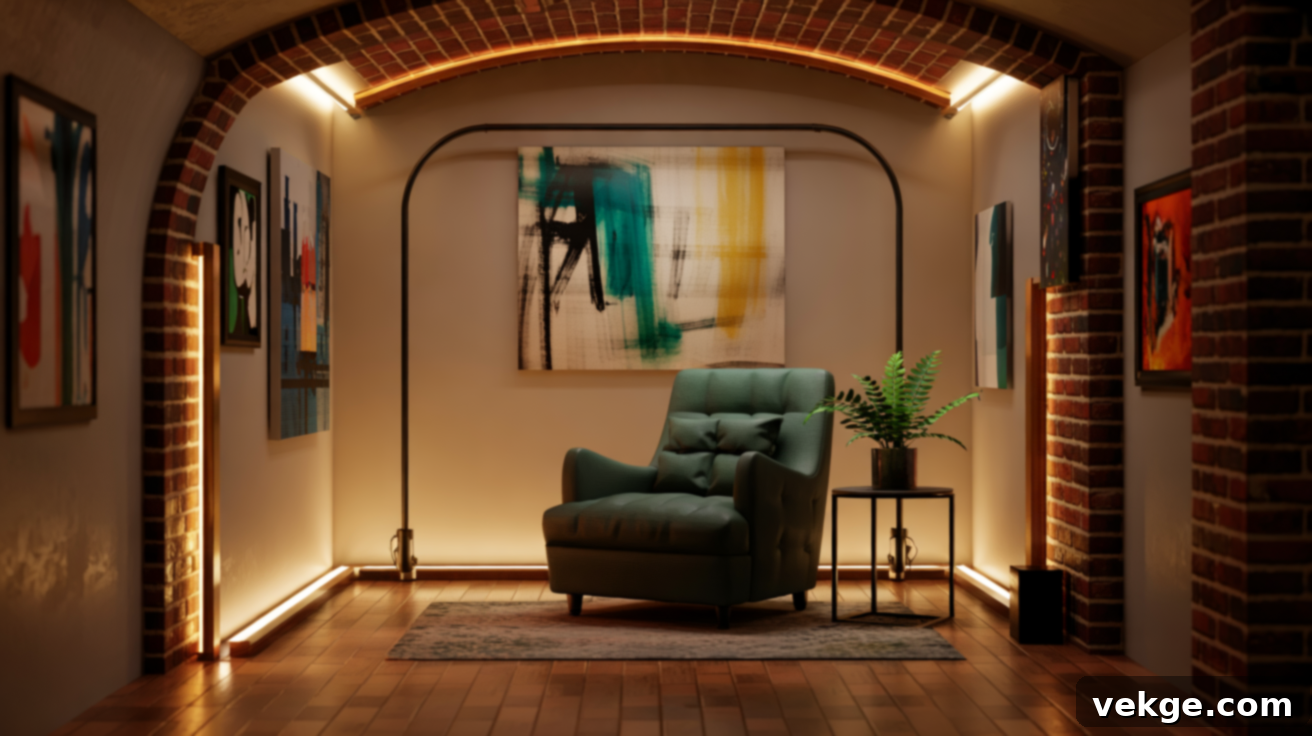
Great for: Adding artistic touches, highlighting specific zones, or providing focused lighting in small to medium-sized rooms with unique architectural details.
Rail lighting systems are a more decorative and often more customizable evolution of track lighting. They typically feature a flexible, curvable rail (or a series of interconnected rigid rails) that can be shaped to follow architectural lines or create unique designs on the ceiling. Like track lights, individual heads can be positioned and aimed along the rail, offering superb directional control. This makes them perfect for rooms with complex vaulted geometries or for creating a bespoke lighting statement.
Use tips:
- Tailored Shapes: Choose a rail shape that either complements your ceiling’s unique design (e.g., curving with a barrel vault) or creates an interesting visual contrast.
- Glare Avoidance: Ensure sufficient spacing between light heads to prevent glare, especially when aiming lights upward towards the ceiling’s reflective surfaces.
- Targeted Illumination: Ideal for precisely lighting shelves, accentuating textured walls, illuminating display cabinets, or providing focused task lighting in specific zones.
- Low Voltage Options: Many rail systems are low voltage, allowing for more compact fixtures and often easier installation due to thinner wires.
7. Wall Sconces with Upward Glow
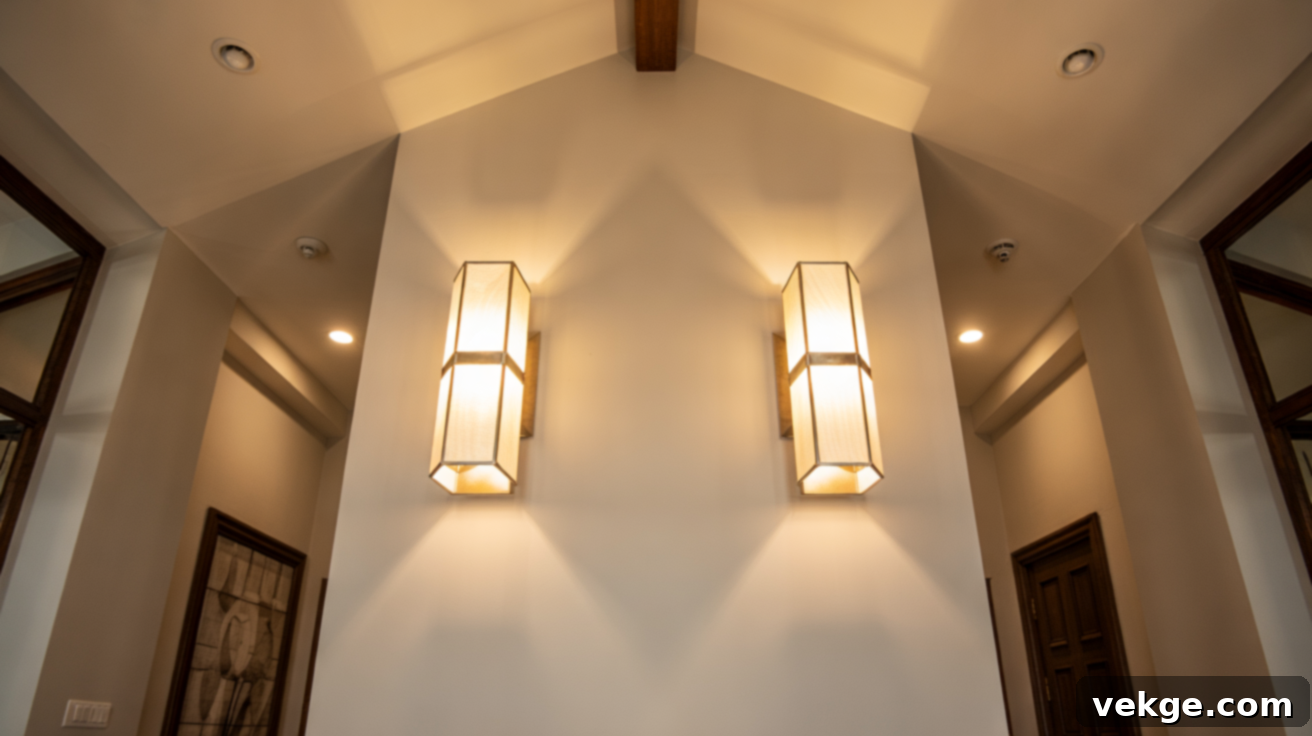
Perfect for: Providing ambient or accent lighting, softening harsh shadows, and drawing attention to the height of the walls and ceiling.
Wall sconces, especially those designed to cast light upwards, are an excellent supplementary lighting solution for vaulted ceilings. By bouncing light off the ceiling and upper walls, they create a soft, diffused ambient glow that makes the room feel brighter, larger, and more inviting. This indirect lighting helps to fill in shadows that overhead fixtures might miss, creating a layered and rich lighting scheme.
Best practices:
- Tall Wall Application: Use sconces on taller wall sections to maximize the upward light spread and effectively illuminate the vast vertical surfaces.
- Even Spacing: Space them out evenly along the walls to achieve a balanced and harmonious light distribution, avoiding “hot spots” or dark areas.
- Warm Light Bulbs: Opt for warm color temperature (2700K-3000K) bulbs to enhance comfort and create a cozy, inviting atmosphere.
- Design Integration: Choose sconces whose style and finish complement your room’s decor, becoming an integral part of the overall design.
8. LED Strip Lighting on Beams
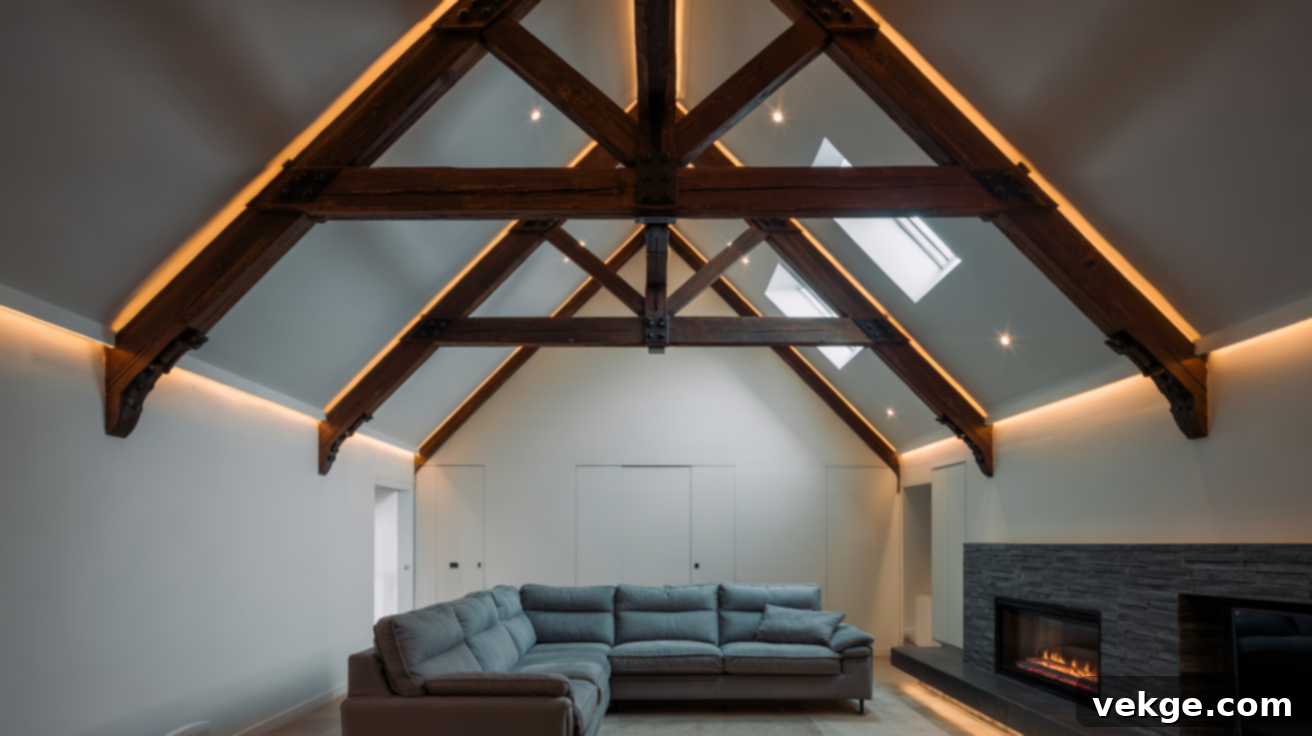
Useful for: Adding subtle, indirect, and customizable mood lighting without any visible fixtures, particularly effective in vaulted ceilings with exposed architectural beams.
If your vaulted ceiling features exposed wooden beams or coffers, LED strip lighting offers a fantastic opportunity to add ambient light and highlight these architectural elements. By discreetly placing LED strips along the top edges of beams or within coves, you can create a gentle, diffused “uplighting” effect that washes the ceiling in light, accentuating its height and texture. This method delivers a clean, modern aesthetic and can be incredibly impactful for mood lighting.
Why it works:
- Gentle Glow: Provides a soft, ambient glow that is not harsh or direct, ideal for creating a relaxed atmosphere in the evenings.
- Easy to Install and Hide: LED strips are flexible, easy to cut to length, and can be easily concealed behind beams or in coves, making them almost invisible when turned off.
- Versatile Control: Many LED strip systems offer color-changing (RGB) capabilities, dimming functions, and smart home integration, allowing for complete customization of your room’s ambiance.
- Highlighting Architecture: Effectively draws attention to the unique structure of your vaulted ceiling, making the beams a feature of the lighting design.
9. Skylights with Built-In Lights
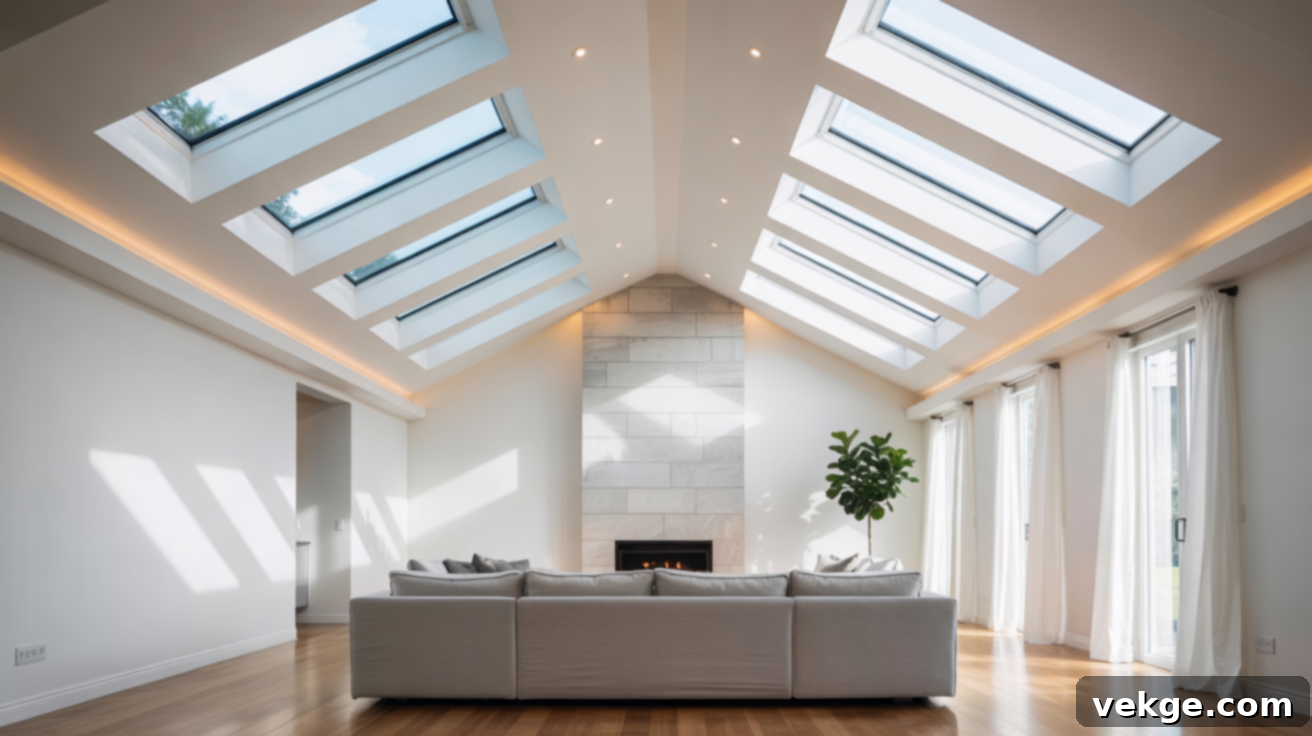
Nice for: Rooms that benefit from abundant natural light during the day and require seamless, integrated illumination after sunset, especially in areas with limited wall space for traditional fixtures.
For vaulted ceilings, skylights are already a natural fit, inviting glorious natural light and often enhancing the sense of spaciousness. Some modern skylight models come with built-in LED lights or integrated blinds that include lighting, offering a dual solution for both daytime natural light and nighttime artificial illumination. This integrated approach saves valuable ceiling space and provides a very clean, contemporary look, minimizing the need for additional ceiling-mounted fixtures.
What to consider:
- Combined Functionality: Provides both natural daylight and artificial light from a single ceiling opening, optimizing space and design.
- Energy Efficiency: Modern skylights are highly energy-efficient, and their built-in LED lights are typically very low power consuming. Some even integrate with solar panels to power the internal lights.
- Remote Control and Automation: Look for models with remote controls, automatic timers, or smart home compatibility for effortless operation of both the skylight (if it opens) and its integrated lighting.
- Daylight Harvesting: Maximizes natural light during the day, reducing reliance on artificial lighting and lowering energy bills.
10. Monorail Lighting
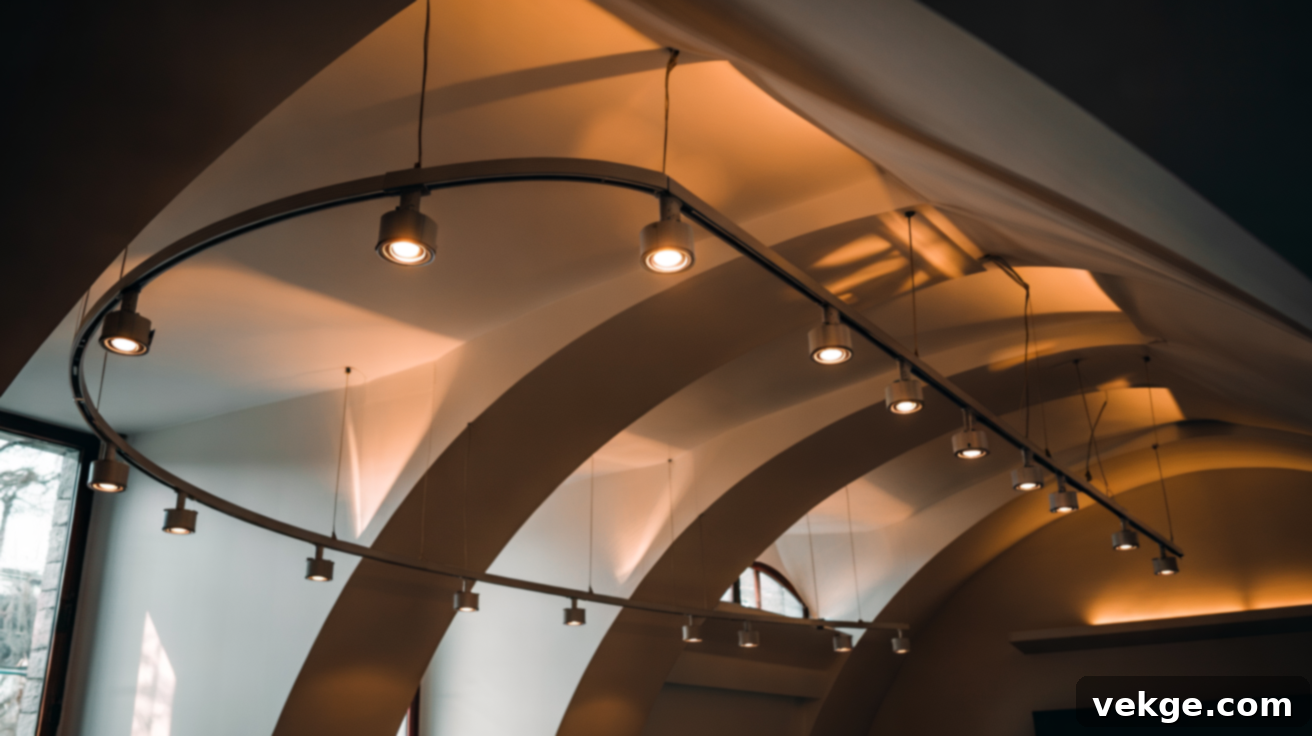
Best for: Rooms with curved, uneven, or highly architectural vaulted ceilings where traditional track lighting might not conform well.
Monorail lighting is a highly flexible and aesthetically pleasing alternative to standard track lighting. It utilizes a single, often bendable, low-voltage rail that can be shaped and curved to follow the contours of your vaulted ceiling or create unique sculptural forms. Various light fixtures, including mini-pendants and spotlights, can be attached to the monorail, allowing for precise directional lighting and artistic expression. Its customizable nature makes it ideal for complex or uniquely shaped vaulted spaces.
Key tips:
- Customizable Path: The bendable rail works exceptionally well with vaulted or curved ceiling designs, allowing for a seamless integration with the room’s architecture.
- Direct and Indirect Lighting: Capable of providing both focused direct lighting (spotlights for task/accent) and gentle indirect lighting (mini-pendants with diffusers) from the same system.
- Aesthetic Integration: Its sleek design and ability to be custom-shaped allow it to blend beautifully into ceiling finishes or become a design feature in itself.
- Low Voltage Safety: Most monorail systems operate on low voltage, which can be safer and easier to work with during installation.
11. Flush Mount Fixtures
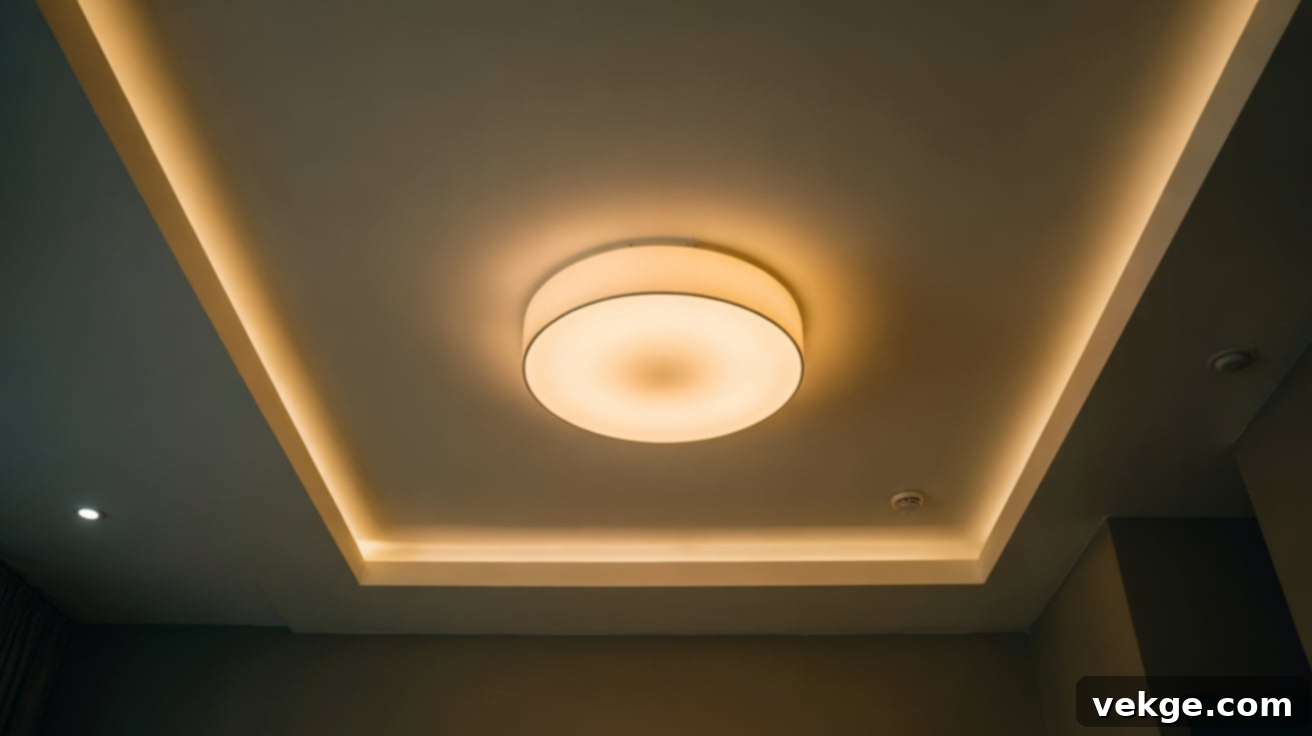
Works best: In sections of lower vaulted ceilings, smaller rooms, hallways, or utility areas where a minimalist, space-saving lighting solution is needed.
While often associated with flat ceilings, flush mount fixtures can still play a valuable role in lighting vaulted ceilings, particularly in areas where the ceiling height is not excessively tall, or where you need unobtrusive, general lighting. These lights sit close to the ceiling, protruding minimally, making them a discreet choice. They are especially useful in the lower-sloped sections of a vaulted ceiling or in adjoining spaces with slightly lower heights where you don’t want hanging fixtures.
Things to note:
- Simple Design: Opt for simple, clean designs that complement the architectural lines of your vaulted space without drawing too much attention.
- LED Bulbs: Choose flush mounts that utilize bright LED bulbs for optimal illumination, as their proximity to the ceiling means light spread needs to be efficient.
- Strategic Placement: Great for hallways, walk-in closets, compact rooms, or as supplementary ambient lighting in combination with other fixture types in larger vaulted spaces.
- Semi-Flush Options: For slightly more decorative appeal while maintaining a low profile, consider semi-flush mount fixtures which hang a few inches below the ceiling.
12. Swing Arm Lights
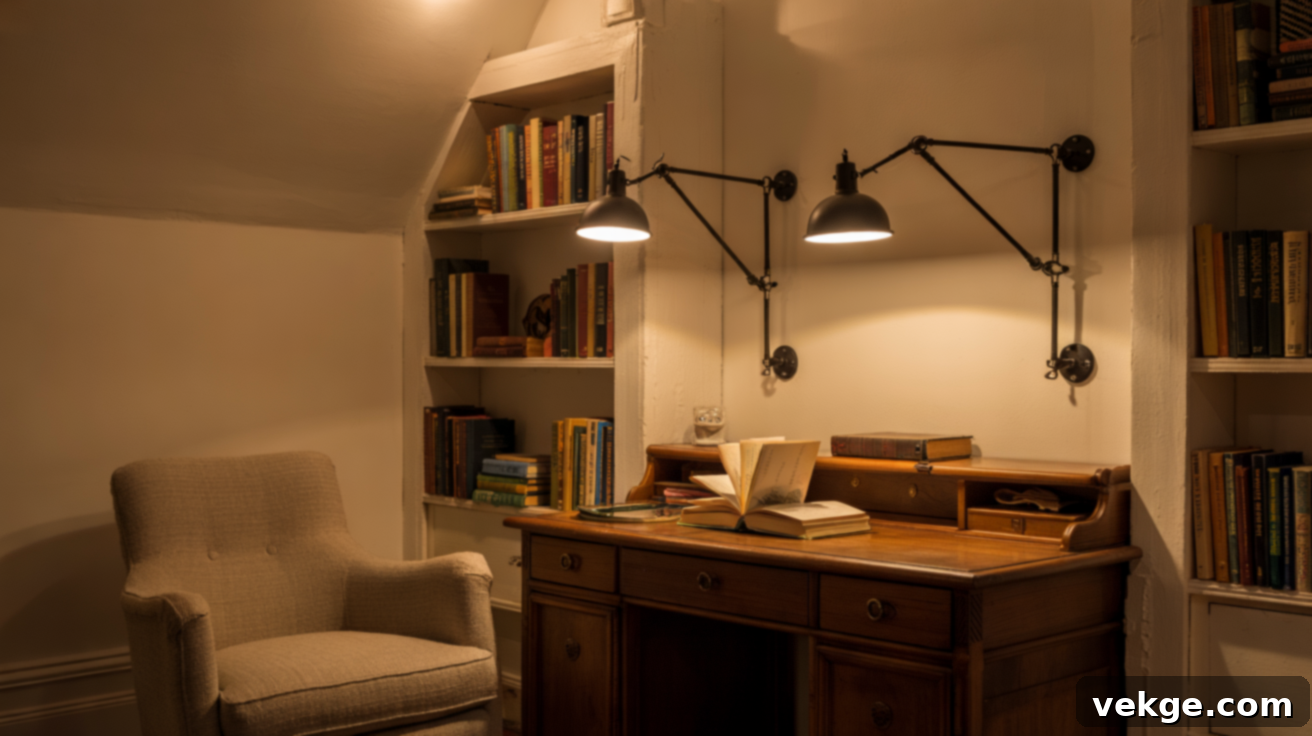
Good for: Flexible task lighting in reading nooks, home offices, or beside beds where adjustability is paramount and floor/table space needs to remain clear.
Swing arm lights are wall-mounted fixtures featuring an adjustable arm that allows the light source to be extended, retracted, and pivoted. While not directly ceiling-mounted, they are an excellent solution for vaulted ceilings by providing highly flexible task lighting that can be aimed precisely where needed. They help free up valuable floor and table space, making them practical for areas like a reading chair under a high window or a desk nestled against a sloped wall.
Setup tips:
- Adequate Reach: Ensure the swing arm light has sufficient reach to cover the desired task area from its wall-mounted position.
- Focused Illumination: Ideal for providing concentrated light for activities like reading, crafting, or working, especially in areas that might be under-lit by general overhead lighting due to the ceiling height.
- Space-Saving: Keeps surfaces clear, contributing to a clean and uncluttered look in rooms with vaulted ceilings.
- Complementary Lighting: Often used as a supplementary light source alongside ambient ceiling lights or floor lamps.
13. Dual-Mount Fixtures
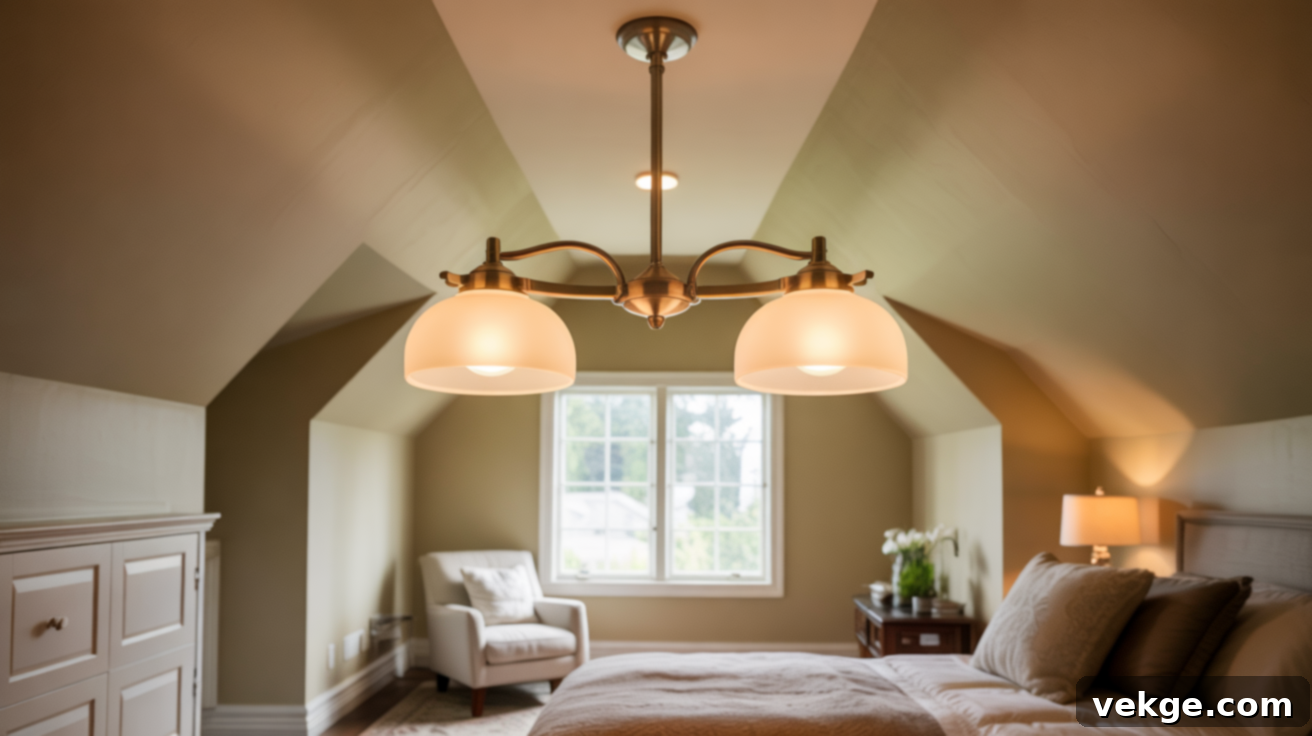
Best for: Rooms with medium-height vaults, areas where ceiling height varies, or situations where you want the flexibility to choose between a flush and semi-flush installation.
Dual-mount fixtures offer exceptional versatility, as they can be installed in two ways: either as a flush mount (directly against the ceiling) or as a semi-flush mount (hanging slightly lower via a short rod or chain). This adaptability makes them a practical choice for vaulted ceilings, especially in rooms where the ceiling height might not be excessively high, or where you prefer to adjust the fixture’s drop based on the specific slope or overall room design. They provide a bridge between the low profile of a flush mount and the slight drop of a small pendant.
Use ideas:
- Bedroom Versatility: Great for bedrooms, dens, or casual living areas where you might appreciate the option to adjust the light’s presence.
- Overhead Light, Less Drop: Works well when you need effective overhead light but want to avoid a lengthy drop that might interfere with sightlines or perceived space in a medium-height vaulted room.
- Design Consistency: Choose designs that are aesthetically pleasing in both flush and semi-flush configurations to maintain a consistent look throughout the home.
- Transitional Spaces: Useful in transitional areas or hallways that connect different ceiling heights, offering a flexible lighting solution.
Tips for Successful Installation on Vaulted Ceilings
Installing lighting fixtures on a vaulted ceiling demands a higher degree of planning and care compared to standard flat ceilings. The unique angles, significant height, and often complex wiring considerations necessitate a thoughtful approach to ensure safety, optimal performance, and aesthetic integration. Following these essential tips will help you plan ahead, ensuring your new lighting is installed securely, effectively, and beautifully.
- Accurate Measurement is Key: Before purchasing any fixture, precisely measure the distance from the floor to the ceiling peak, as well as to any lower sections where you plan to install lights. This measurement dictates the appropriate length of downrods for chandeliers and pendants, ensuring proper clearance and proportion.
- Utilize Sloped Ceiling Adapters: For most hanging fixtures like chandeliers and pendant lights, a specialized sloped ceiling adapter or canopy kit is indispensable. This component ensures that your fixture hangs perfectly vertical, regardless of the ceiling’s angle. Without it, fixtures will hang at an unsightly slant.
- Always Check Weight Limits: Vaulted ceilings, especially older ones, may have specific weight limitations for ceiling-mounted fixtures. Always verify the structural capacity of your ceiling joists before installing heavier lights. When in doubt, reinforce the mounting box or consult a structural engineer.
- Safety First – Professional Help: Working at significant heights and dealing with electrical wiring can be dangerous. If you are not entirely confident in your DIY electrical skills or do not have the proper safety equipment (like a stable, tall ladder or scaffolding), it is always best and safest to call a licensed electrician. They can ensure correct wiring, secure mounting, and adherence to local building codes.
- Consider Accessibility for Maintenance: Think about how you will access the lights for future bulb changes or cleaning. Installing fixtures with long-lasting LED bulbs or smart features that reduce the need for frequent access can save you significant hassle in the long run.
- Plan Your Layout Meticulously: For recessed lighting or track systems, carefully map out the placement of each light. Consider beam angles and spacing to achieve even illumination, avoiding dark spots and excessive glare. For sloped ceilings, ensure recessed cans are rated for sloped installations.
- Verify Electrical Box Support: Ensure that the electrical box where the fixture will attach is adequately rated and securely fastened to support the weight of your chosen light. For heavier fixtures, a brace between joists may be necessary.
Energy Efficiency and Smart Features: Modern Lighting for Modern Homes
Embracing energy-efficient lighting solutions isn’t just a smart financial decision; it’s also an environmentally responsible choice that’s easier than ever to implement. When illuminating vaulted ceilings, where lights often stay on for extended periods and maintenance can be challenging, thoughtful lighting choices can make a substantial difference in both your electricity bills and overall convenience. This section explores simple yet impactful ways to reduce power consumption and integrate smart technology for enhanced control and comfort.
LED Lighting Options: The Future of Illumination
LED (Light Emitting Diode) bulbs are unequivocally the top choice for vaulted ceiling lighting, offering unparalleled advantages over traditional incandescent or fluorescent options. They are a robust investment if your goal is to significantly lower electricity consumption and minimize the frequency of bulb replacements, especially in hard-to-reach areas.
- Exceptional Longevity: LED bulbs boast an incredibly long lifespan, often lasting 25 to 50 times longer than incandescent bulbs. This dramatically reduces the need for precarious ladder climbs to change bulbs in high vaulted ceilings.
- Superior Energy Efficiency: LEDs consume significantly less energy to produce the same amount of light, translating directly into lower utility bills. They convert a much higher percentage of energy into light rather than heat.
- Minimal Heat Emission: Unlike incandescent bulbs, LEDs generate very little heat. This is a crucial safety and practicality benefit for high ceilings, where heat can accumulate and potentially affect surrounding materials or even impact room temperature.
- Versatile Color Temperatures: You can find LED lights in a wide spectrum of color temperatures, from warm white (2700K-3000K) for a cozy, inviting ambiance to cool white (3500K-4000K) for task-oriented areas, and even daylight (5000K-6000K) to mimic natural light. This allows you to perfectly tailor the light to your room’s function and aesthetic.
- Instant On and Dimmability: LEDs provide instant full brightness with no warm-up time and are highly compatible with dimming systems, offering precise control over light intensity.
Smart Bulbs, Dimmers, and Remote Controls: Seamless Control
Integrating smart lighting technology into your vaulted ceiling setup provides an unprecedented level of convenience and control, eliminating the need to physically reach high switches or struggle with inaccessible fixtures.
- Smart Bulbs and Systems: Many smart bulbs allow you to control color, brightness, and even turn lights on/off directly from a smartphone app, regardless of your physical location in the room. They can be integrated into broader smart home ecosystems (like Amazon Alexa, Google Home, Apple HomeKit) for voice control and advanced automation.
- Dimmers for Ambiance: Dimmers are essential for vaulted ceilings. They allow you to fine-tune the light output, transforming a brightly lit space for tasks into a softly lit, ambient environment for relaxation. This adds significant versatility to any lighting scheme.
- Remote Controls for Accessibility: For lights that are out of arm’s reach, dedicated remote controls offer a simple and effective way to manage brightness and settings without needing to access a wall switch or an app.
- Automation and Scheduling: Smart lighting systems can be programmed with timers, schedules, or even motion sensors. Imagine lights turning on automatically as you enter a room, or gently dimming as evening approaches, all without a single interaction.
Solar-Powered Options for Skylights: Harnessing Natural Energy
For rooms with vaulted ceilings that can accommodate skylights, integrating solar-powered lighting options is an innovative way to enhance both natural and artificial illumination, further boosting energy efficiency.
- Solar Skylights & Tubes: These systems channel natural daylight into interior spaces through a reflective tube, significantly reducing the need for artificial lighting during the day. They operate entirely on sunlight and require no electricity from your home’s grid.
- Integrated Night Lighting: Some advanced solar skylight models come equipped with a small, built-in LED light powered by a discreet solar panel and battery. This allows the skylight to provide gentle, ambient light after the sun sets, using stored solar energy.
- Additional Features: Beyond lighting, some solar-powered skylight systems also offer integrated features like small fans for passive ventilation or night lights for safety, contributing to overall comfort and reduced energy reliance.
- Ideal for Remote Areas: These solutions are particularly helpful in areas where running traditional wired electrical fixtures might be difficult, costly, or aesthetically undesirable. They offer a self-contained, sustainable lighting option.
Buying Guide: Key Considerations for Your Vaulted Ceiling Light
Navigating the vast market of lighting fixtures can feel overwhelming, especially when you’re dealing with the unique requirements of a vaulted ceiling. To simplify your decision-making process, this buying guide focuses on critical factors such as material, size, finish, and cost. By prioritizing these elements, you can select the perfect lighting solutions that not only fit your aesthetic preferences but also perform optimally in your distinctive space.
Consider the following table to get a general idea of fixture types, their typical price ranges, and materials best suited for vaulted ceilings. Remember that prices can vary greatly based on brand, design complexity, and specific features.
| Fixture Type | Estimated Price Range | Material and Finish Considerations for Vaulted Ceilings |
|---|---|---|
| Pendant Lights | $40–$200 | Look for lightweight, durable materials like rust-resistant metal (e.g., brushed nickel, bronze) or natural wood. Matte finishes can reduce glare, while clear or frosted glass diffusers soften light. Adjustable cords are essential. |
| Chandeliers | $150–$1000+ | Larger models in robust materials like forged iron, solid brass, or elegant crystals best suit tall spaces and create a grand statement. Choose solid, non-tarnishing finishes that complement the room’s décor. Weight and secure mounting are critical. |
| Recessed Lighting | $20–$60 per unit | Focus on trim options: black or white for blending in, brushed metal for a modern touch. “Sloped ceiling” specific trims are vital for proper light direction. Durable housing and good heat dissipation are important for longevity. |
| Ceiling Fans w/ Light | $100–$500 | Seek out sealed finishes that hold up well in various climates. Blades in wood, composite, or metal should complement your interior. Ensure the downrod is long enough and rated for sloped ceilings to maintain stability and performance. |
| Track Lighting | $60–$300+ | Powder-coated metal (black, white, silver) or brushed metal are practical and modern choices. Choose durable tracks and adjustable heads, with good heat dissipation for the bulbs. Consider low-voltage systems for greater flexibility. |
| Wall Sconces | $30–$250 | Materials like metal, glass, and even fabric shades can work. Ensure the finish matches other fixtures. Look for designs that cast light upwards to wash the vaulted ceiling, avoiding direct glare. |
| LED Strip Lighting | $20–$100 per roll | Silicone or epoxy-coated strips for durability, especially if exposed to dust. Opt for high-quality LEDs for consistent color and brightness. Aluminum channels can provide a cleaner look and better heat management. |
When making your final decision, also consider the light output (lumens) required for your large space, the color temperature (Kelvin) to set the mood, and the fixture’s compatibility with dimmers and smart home systems. Always measure your space and consult with professionals if you have any doubts about installation or structural support.
Maintenance and Long-Term Use: Keeping Your Vaulted Ceiling Lights Shining
Ensuring your vaulted ceiling lighting remains in pristine condition and functions optimally doesn’t have to be a daunting task. A proactive approach to maintenance, even for fixtures located at significant heights, can extend their lifespan, preserve their aesthetic appeal, and guarantee that your space remains safely and beautifully lit. Given the challenges of accessing these fixtures, strategic planning for care and long-term use is paramount.
- Regular, Gentle Dusting: For light dusting, use a microfiber duster with an extendable pole. This allows you to reach high fixtures without a ladder, removing accumulated dust that can dull light output and clarity. Make this a part of your regular cleaning routine.
- Scheduled Deep Cleaning: For a more thorough cleaning of fixtures like chandeliers or glass pendants, a stable, tall ladder (or even scaffolding, depending on height) is usually necessary. Always have someone nearby to assist for safety. Use a soft, damp cloth with a mild, non-abrasive cleaner, and ensure the fixture is completely cooled and powered off before cleaning.
- Safe Bulb Replacement: When it’s time to change a bulb (less frequent with LEDs, thankfully!), always cut the power to the fixture at the circuit breaker. Use a sturdy, properly secured ladder, and consider long-handled bulb changing tools if available for extremely high recessed lights. Never overreach or stand on unstable surfaces.
- Prioritize Long-Lasting Bulbs: To minimize the need for frequent access, always choose long-lasting LED bulbs. Their extended lifespan significantly reduces maintenance intervals, making them ideal for hard-to-reach vaulted ceiling fixtures.
- Consider Adjustable Fixtures for Future Flexibility: If you anticipate redecorating, moving furniture, or changing your room’s layout in the future, select fixtures with adjustable elements. Track lights, rail lights, and pendants with adjustable cords allow you to re-aim or re-position light sources to adapt to new arrangements without needing to reinstall entire systems.
- Regular Inspections: Periodically, or during other maintenance, visually inspect your fixtures. Look for any loose wires, flickering lights, or signs of wear and tear. Address any issues promptly, calling a qualified electrician if you suspect a more serious electrical problem.
- Maintain Smart Systems: If you have smart lighting, ensure your Wi-Fi network is stable and that apps and firmware are updated regularly. This keeps your smart features working seamlessly and securely.
Final Thoughts: Illuminating Your Vaulted Vision
Lighting for vaulted ceilings, while initially appearing complex, is an exciting opportunity to showcase your home’s unique architectural beauty. We’ve journeyed through the distinct characteristics of vaulted ceilings, explored a diverse array of suitable lighting fixtures—from grand chandeliers to discreet recessed lights—and delved into the practicalities of installation, energy efficiency, and ongoing maintenance.
You now possess a robust understanding of the best practices for illuminating any vaulted space, regardless of its size, slope, or style. From creating ambient layers with wall sconces and LED strips to providing focused task lighting with pendants and track systems, the possibilities are vast and entirely customizable to your needs. The key lies in strategic planning, selecting appropriate fixtures that complement your ceiling’s scale, and leveraging modern technologies for convenience and energy savings.
We hope this guide has not only clarified the complexities but also ignited your imagination, giving you the confidence and inspiration needed to transform your vaulted spaces into brilliantly lit, inviting, and truly spectacular environments. Remember, every ceiling tells a story, and your lighting should perfectly articulate that narrative, enhancing both the functionality and the aesthetic appeal of your home.
Should you seek further inspiration, detailed design ideas, or wish to explore more innovative lighting solutions, we invite you to browse our other comprehensive blogs and resources. You might just discover that perfect finishing touch your unique space has been waiting for.
